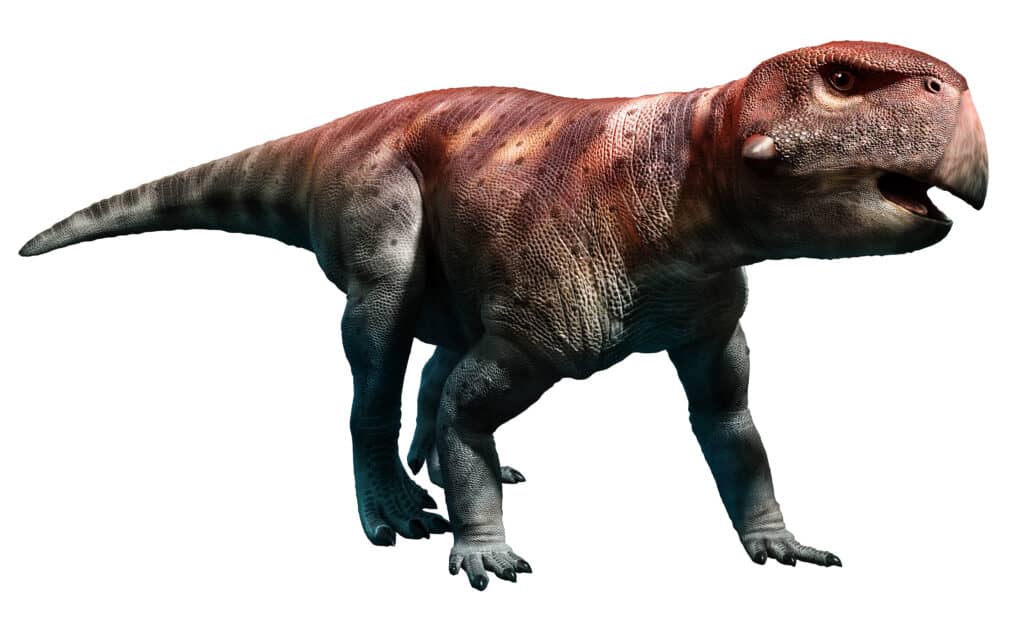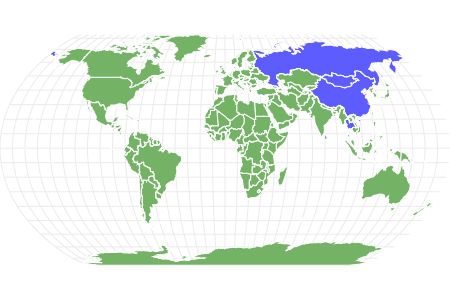Psittacosaurus
The Psittacosaurus dinosaurs had four limbs but were mostly bipedal.
Advertisement
Psittacosaurus Facts
- Fun Fact
- The Psittacosaurus dinosaurs had four limbs but were mostly bipedal.
- Biggest Threat
- Larger carnivorous dinosaurs
- Most Distinctive Feature
- Psittacosaurus had a mouth modified to form a beak.
- Distinctive Feature
- Psittacosaurus had very short forelimbs
Psittacosaurus Physical Characteristics
- Weight
- 44lbs (20kg)
- Height
- 0.6m (2ft)
- Length
- 2m (6.5ft)
- Venomous
- No
- Aggression
- Low
View all of the Psittacosaurus images!
The Psittacosaurus is a genus of beaked dinosaurs that lived during the late Cretaceous about 100 to 120 million years ago. The group is a well-known one and has been widely studied by scientists. Hundreds of fossils belonging to several species of Psittacosaurus have been discovered in various locations across China, Mongolia, Thailand, and Russia.
Description and Size

A 3D illustration of Psittacosaurus.
©iStock.com/Warpaintcobra
Psittacosaurus is a genus of ceratopsian dinosaurs that lived during the early Cretaceous period. Members of this ceratopsian suborder have their mouths modified into beaks. In fact, the name Psittacosaurus translates into parrot-lizard, and it refers to the fact that this dinosaur had a mouth modified to form a beak. The anterior region of the Psittacosaurus’ skull was shaped like a parrot’s beak, with the upper jaw curved over the lower one.
Scientists believe that the Psittacosaurus evolved from bipedal ornithopod dinosaurs around the Early Cretaceous Period, making it one of the earliest ceratopsians. It is also one of the most species-rich dinosaur genera, with up to 12 species known so far.
The different members of this genus varied largely in size and had specific features. However, their overall body shape was essentially the same. Psittacosaurus dinosaurs were about the size of a gazelle. The best-known species in the group, Psittacosaurus mongoliensis, was about 6.5 feet long and weighed up to 44 pounds. There were some slightly smaller species, such as P. sinensis and P. meileyingensis. The smallest member of this genus was the P. ordosensis which was about 30% smaller than P. mongoliensis, while the largest was P. lujiatunensis.
This dinosaur had four limbs but was mostly bipedal. Their forelimbs were significantly shorter than their hind limbs, suggesting that they rarely used them. Each limb had only four digits. This is another difference between them and other members of the Ornithischia, characterized by a five-toed foot.
Diet – What Did Psittacosaurus Eat?
Psittacosaurus was an herbivore. The bony core of their parrot-like beak had a sheat cover made of keratin. This provided a sharp surface for cutting plant materials. Their teeth were self-sharpening and would have been useful for slicing through tough materials.
Many ceratopsians had teeth for grinding and chewing their food, but this was absent in the Psittacosaurus. Instead, they had gastrolith stones in their stomach, which helped to wear down food in their digestive system. Paleontologists found up to fifty gastroliths in the abdomen of some Psittacosaurus. Experts think they might have had a gizzard like many modern birds.
Habitat – When and Where It Lived
Psittacosaurus is a well-known species with several species found in deposits dating back to the early Cretaceous (between 126 to 101 million years ago). Most species have been found in Asia in locations like China, Thailand, and Mongolia. However, paleontologists have also unearthed fossils in parts of Siberia and Russia.
By studying some well-preserved fossils of the Psittacosaurus, scientists could determine that it had colorful skin and might have exhibited a form of color adaptation known as countershading. Researchers determined that this adaptation would have helped it survive by blending in with the dense dark forest habitat where it lived.
Threats and Predators
The Psittacosaurus was herbivorous and didn’t have any notable defense against predators. This means it would have fallen prey to other dinosaurs quite easily.
The discovery of the interaction of this dinosaur with another fossil that lived around the same time provides a clue about the Psittacosaurus’ position on the food chain. Experts found fossils of a Repenomamus giganticus, a type of large triconodont mammal that lived in the Cretaceous, with remains of a Psittacosaurus in its abdominal cavity. Several of the small dinosaur’s bones were still intact, indicating that the carnivorous mammal probably swallowed it in large chunks. To survive predation, the Psittacosaurus produced numerous offspring and provided communal parental care similar to modern ostriches.
Discoveries and Fossils – Where It Was Found
The Psittacosaurus is one of the most well-known and studied dinosaur fossils. The most abundant species in the group is the P. mongoliensis, with up to 75 fossils found so far.
All Psittacosaurus fossils that paleontologists have found so far were from Early Cretaceous sediments in Asia and some parts of Europe. Some of the most notable finds have been in China, Thailand, and Mongolia. They have also been found in parts of southern Siberia and Russia.
The first species that paleontologists unearthed was P. lujiatunensis. The specimen was found in the lowest beds of the Yixian Formation in China. More than 200 fossils belonging to members of this genus have been recovered from this formation alone.
One of the most remarkable finds of Psittacosaurus fossils was the discovery of a nest with six juveniles buried in volcanic ash. The young Psittacosaurus were of different age ranges, which suggests that they were raised together as a group and were probably not from the same parent. Based on this observation, scientists concluded that these dinosaurs might have congregated in flocks.
Extinction – When Did Psittacosaurus Die Out?
The exact period of the Psittacosaurus’s extinction isn’t well-known, and scientists are uncertain about what could have caused their extinction. However, they most likely lived till the mid-Cretaceous period (about 100 million years ago).
Similar Animals to the Psittacosaurus
Similar dinosaurs to the Psittacosaurus include:
- Triceratops: This is an herbivorous dinosaur that lived during the Late cretaceous. Like the Psittacosaurus and other Ceratopsians, the mouth of the Triceratops was also a beak. However, Triceratops were significantly larger than the Psittacosaurus.
- Archaeopteryx: Archaeopteryx is a bird-like dinosaur that lived during the Late Jurassic. Scientists consider the Archaeopteryx as a transition between dinosaurs and birds.
- Yinlong: This is a genus of ceratopsian dinosaurs that lived in Asia during the Late Jurassic period. It was bipedal like the Psittacosaurus and fed on plants as well.
Related Animals…
View all 192 animals that start with PPsittacosaurus FAQs (Frequently Asked Questions)
When was the Psittacosaurus alive?
The Psittacosaurus lived in Asia during the early part of the Cretaceous period. This was about 126 to 101 million years ago.
How big was the Psittacosaurus?
The Psittacosaurus was about the same size as a gazelle. On average, they stood at about 2 feet and were about 6.5 feet long. They weighed up to 44 pounds. Some species were slightly smaller, while some were bigger than this.
Why was the Psittacosaurus so called?
Psittacosaurus is derived from a Greek word that translates as ‘parrot lizard’, a reference to the beaked mouth of this dinosaur.
Did Psittacosaurus have teeth?
Yes, Psittacosaurus had sharp self-sharpening teeth for cutting and slicing plants. However, they had no chewing teeth. Instead, they had gastroliths in their stomach for grinding food.
Thank you for reading! Have some feedback for us? Contact the AZ Animals editorial team.
Sources
- Britannica, Available here: https://www.britannica.com/animal/Psittacosaurus
- Wikipedia, Available here: https://en.wikipedia.org/wiki/Psittacosaurus
- McGill School of Computer Science, Available here: https://www.cs.mcgill.ca/~rwest/wikispeedia/wpcd/wp/p/Psittacosaurus.htm

















